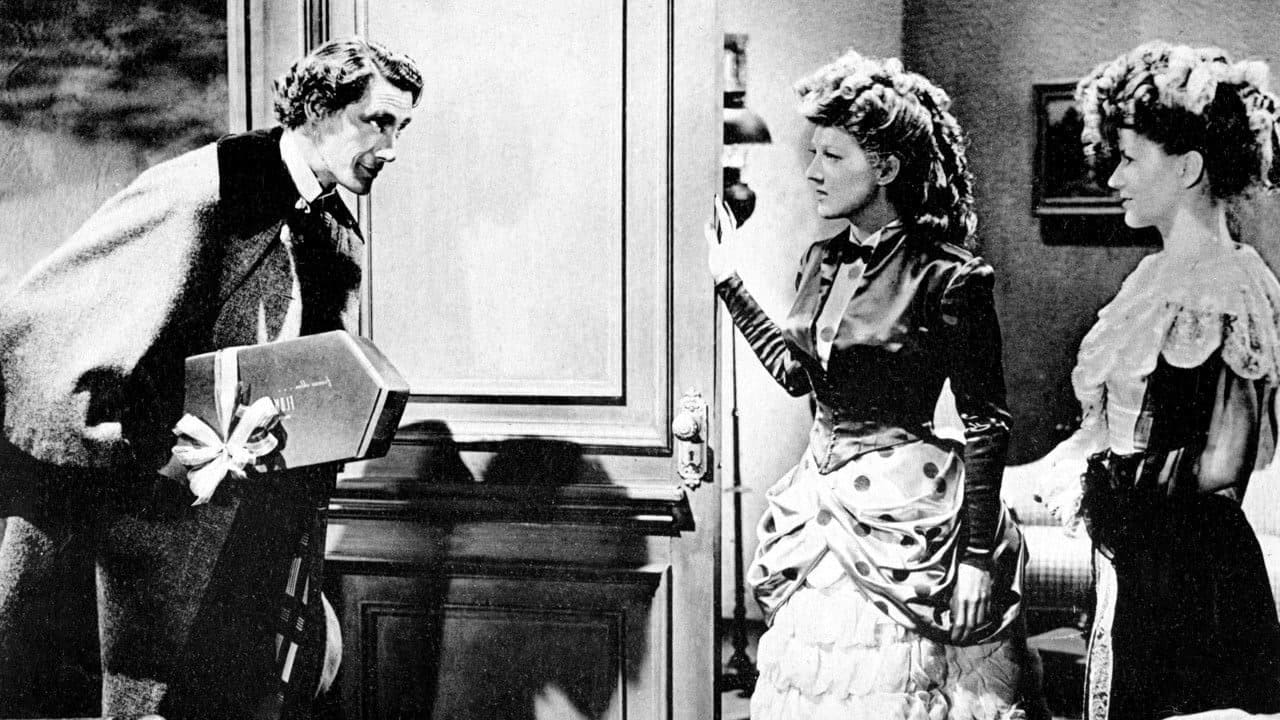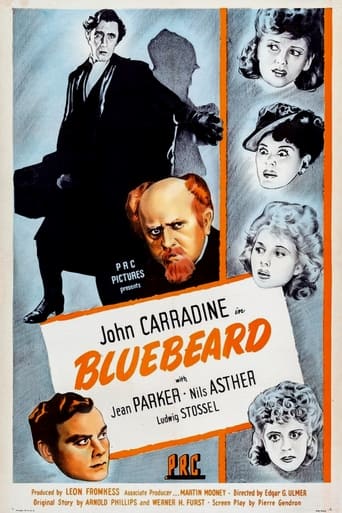

Why so much hype?
... View MoreThis Movie Can Only Be Described With One Word.
... View Morejust watch it!
... View MoreThe joyful confection is coated in a sparkly gloss, bright enough to gleam from the darkest, most cynical corners.
... View MorePRC thriller has a few things going for it. First, John Carradine in one of his rare starring roles. Carradine was proud of his performance and he should have been. He's excellent. Second, the radiant Jean Parker. She always had a sweet gentility about her. Such a beauty. Third, director Edward G. Ulmer, who deservedly has a cult following. He uses quite a few interesting angles and techniques, never letting his limited budget stop him from being creative. There's a great moody atmosphere to this film, due in large part to his use of shadow and music. There's also a good supporting cast, including Nils Asther as the inspector on Bluebeard's trail, Ludwig Stossel as the disreputable accomplice of Bluebeard, and the beautiful Teala Loring as the sister of Jean Parker's character. Speaking of sisters: Loring was the sister of actresses Lisa Gaye and Debra Paget. Talk about good genes!
... View MoreJohn Carradine appears in a rare leading role in this bargain-basement PRC production helmed by legendary B movie director Edgar Ulmer. He appears in the role of Bluebeard, a man who preys on women in a serial fashion in the streets. Nevermind that the historical Bluebeard was supposed to be a guy who married his victims, that wouldn't fit into the running time of this film. You have to see Chaplin's "Monsieur Verdoux" for that. But this isn't a bad little movie, taken for what it is.Carradine looks very striking in a hairstyle that emphasizes Oscar Wilde-ish bangs. He's an artist who murders the women that he paints, and so he's very keen not to paint a particular lady who he's convinced is a better type of lady, portrayed by Jean Parker (who can't really hold her weight on screen against Carradine). Carradine's odd manner of delivery never really suited a character better than this one. Still I'm left feeling that the movie has a bit of a cold heart. Characters are killed off towards the end in a way that is sort of casual, and we never get invested enough in any of the characters to really care one way or the other. Ulmer's mood and atmosphere are far more compelling than any of the performances he's able to elicit.
... View MoreFailed painter turned puppeteer John Carradine (as Gaston Morrell) is secretly terrorizing 19th century Paris, as the serial killer nicknamed "Bluebeard" (since nobody knows who he is, the name is moderately appropriate). After strangling the women, Mr. Carradine dumps them into the river Seine. The reasons for Carradine's homicidal behavior are, later, explained (in a nicely performed scene); predictably, they involve his relationship with women. Carradine's Achilles' heel appears in the form of slim-waisted seamstress Jean Parker (as Lucille). Carradine has stated the title role of "Bluebeard" was his favorite performance. The film's surprisingly weak structure and glaring soundtrack are among the obvious flaws; but, there are some enjoyable and entertaining elements present. The film is directed with style, and includes some fine performances. Carradine's characterization is, obviously, most appealing. There are other players worth watching; and, director Edgar G. Ulmer must deserve great credit. Ms. Parker helps a great deal; her character's approaching spinsterhood helps make the film, and its characters, seem more authentic. Other thirtysomething actresses of the 1940s would have declined the line, "Are you disappointed after seeing me more closely?" Nils Asther (as Lefevre) is another underrated performer appearing; his Parisian inspector, with an eye for art, is outstanding. Also notable is Sonia Sorel (as Renee); she was one of Carradine's wives, and the mother of Keith and Robert. ******* Bluebeard (1944) Edgar G. Ulmer ~ John Carradine, Jean Parker, Nils Asther
... View MoreA PRC poverty row production that makes the most of its limited budget. A lot of credit should go to production designers Eugene Shufftan and Edgar Ulmer who collaborated on the movie's sumptuous look. Even when the middle part drags, the visuals remain arresting. Note too how the meagre exterior sets are stylized to make up for the limitations. Of course, cult director Ulmer was no stranger to transforming army surplus material into artistic effects. The overall result is an atmospheric recreation of 19th century Paris. Making Carradine's Bluebeard a puppeteer is a novel and interesting wrinkle. Then too, I can't help thinking there is more plot potential in continuing with Bluebeard the puppet master than in shifting the story line over to Bluebeard the painter, as the screenplay does. Nonetheless, those early scenes in the park are good ones. However, the cadaverous actor who can be as florid and intense as anyone seems a little too understated here. While physically he looks the part of the grim reaper, Carradine is simply no good as a simpering lover, while too many of his scenes lack the menace the role calls for. Unfortunately, the result compares unfavorably, for example, with Laird Cregar's riveting Jack the Ripper in that Gothic thriller The Lodger of the same year. It appears Ulmer is much more the visual artist than the thespic coach.Nonetheless, the movie remains an interesting curiosity. Consider the sheer wackiness of presenting Iris Adrian whose cheap Brooklyn accent can barely be disguised as a Parisian. Still, it does amount to an amusing turn. Also, note the off-angle camera staging of Carradine's flashback sequence, which is both effective in identifying the sequence and artfully composed. Such camera effects were hardly a Hollywood staple at a time when producers generally felt they would confuse the audience.Of course, there's the question that always arises for fans of Ulmer. What would he have done with an A-budget and A-material in a career spent in the lower depths of Hollywood production. Hard to say-- perhaps he needed the challenge of PRC-type constraints. However, I think it's fair to say that none of his poverty row productions are without genuine points of interest and entertainment, and-- as is the case with Bluebeard-- may even rise at times to artistic levels.
... View More